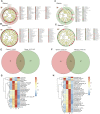Olmesartan Attenuates Single-Lung Ventilation Induced Lung Injury via Regulating Pulmonary Microbiota
- PMID: 35401192
- PMCID: PMC8984607
- DOI: 10.3389/fphar.2022.822615
Olmesartan Attenuates Single-Lung Ventilation Induced Lung Injury via Regulating Pulmonary Microbiota
Abstract
Single-lung ventilation (SLV) associated acute lung injury is similar to ischemia reperfusion (IR) injury which is usually occurred during lung surgery. Olmesartan (Olm), a novel angiotensin receptor blocker (ARB), has been reported to ameliorate organ IR injury. Several recent studies have shown that lung microbiota may be involved in pulmonary diseases, but the effect of pulmonary microbiota in SLV-induced lung injury has not been reported. This study aims to determine the mechanism of how Olm attenuates SLV induced lung injury. Our data showed that 7 days Olm treatment before modeling markedly alleviated SLV-induced lung injury by suppressing inflammation and reactive oxygen species. Bronchoalveolar lavage fluid samples from the injured side were collected for 16S rRNA gene-based sequencing analysis and 53 different bacteria at the genus and species levels were identified. Furthermore, the injured lung samples were collected for metabolomics analysis using liquid chromatography-mass spectrometry analyses to explore differential metabolites. The Kyoto Encyclopedia of Genes and Genomes (KEGG) was applied to analyze the correlation between differential metabolites and lung microbiota. A total of 38 pathways were identified according to differential metabolites and 275 relevant pathways were enriched via analyzing the microbial community, 24 pathways were both identified by analyzing either metabolites or microbiota, including pyrimidine metabolism, purine metabolism, aminoacyl-tRNA biosynthesis and ATP-binding cassette transporter. Besides classical blockage of the renin-angiotensin II system, Olm could also alleviate SLV-induced lung injury by rewiring the interaction between pulmonary microbiota and metabolites.
Keywords: angiotensin receptor blocker; lung injury; metabolite; olmesartan; pulmonary microbiota; single-lung ventilation.
Copyright © 2022 Lu, Wang, Chen, Fan, Zhai, Fang, Cai, Liu, Wu and Cai.
Conflict of interest statement
The authors declare that the research was conducted in the absence of any commercial or financial relationships that could be construed as a potential conflict of interest.
Figures







Similar articles
-
Integrated 16S rRNA Gene Sequencing and Metabolomics Analysis to Investigate the Important Role of Osthole on Gut Microbiota and Serum Metabolites in Neuropathic Pain Mice.Front Physiol. 2022 Feb 7;13:813626. doi: 10.3389/fphys.2022.813626. eCollection 2022. Front Physiol. 2022. PMID: 35197864 Free PMC article.
-
Olmesartan attenuates type 2 diabetes-associated liver injury: Cross-talk of AGE/RAGE/JNK, STAT3/SCOS3 and RAS signaling pathways.Eur J Pharmacol. 2020 May 5;874:173010. doi: 10.1016/j.ejphar.2020.173010. Epub 2020 Feb 14. Eur J Pharmacol. 2020. PMID: 32067934
-
Correlation of the lung microbiota with metabolic profiles in bronchoalveolar lavage fluid in HIV infection.Microbiome. 2016 Jan 20;4:3. doi: 10.1186/s40168-016-0147-4. Microbiome. 2016. PMID: 26792212 Free PMC article.
-
Single-lung ventilation and oxidative stress: a different perspective on a common practice.Curr Opin Anaesthesiol. 2017 Feb;30(1):42-49. doi: 10.1097/ACO.0000000000000410. Curr Opin Anaesthesiol. 2017. PMID: 27783023 Review.
-
Mass spectrometry-based metabolomics: Targeting the crosstalk between gut microbiota and brain in neurodegenerative disorders.Mass Spectrom Rev. 2019 Jan;38(1):22-33. doi: 10.1002/mas.21553. Epub 2017 Nov 12. Mass Spectrom Rev. 2019. PMID: 29130504 Review.
Cited by
-
Ferroptosis in Rat Lung Tissue during Severe Acute Pancreatitis-Associated Acute Lung Injury: Protection of Qingyi Decoction.Oxid Med Cell Longev. 2023 Feb 11;2023:5827613. doi: 10.1155/2023/5827613. eCollection 2023. Oxid Med Cell Longev. 2023. PMID: 36820405 Free PMC article.
-
Penehyclidine hydrochloride alleviates lung ischemia-reperfusion injury by inhibiting pyroptosis.BMC Pulm Med. 2024 Apr 26;24(1):207. doi: 10.1186/s12890-024-03018-5. BMC Pulm Med. 2024. PMID: 38671448 Free PMC article.
-
One lung ventilation during thoracoscopic lobectomy alters lung microbiome miversity and composition.Sci Rep. 2025 Feb 10;15(1):4937. doi: 10.1038/s41598-025-89233-4. Sci Rep. 2025. PMID: 39929955 Free PMC article.
-
Baicalin Protects Broilers against Avian Coronavirus Infection via Regulating Respiratory Tract Microbiota and Amino Acid Metabolism.Int J Mol Sci. 2024 Feb 9;25(4):2109. doi: 10.3390/ijms25042109. Int J Mol Sci. 2024. PMID: 38396786 Free PMC article.
-
Transcutaneous electrical acupoint stimulation improves pulmonary function by regulating oxidative stress during one-lung ventilation in patients with lung cancer undergoing thoracoscopic surgery: a randomized controlled trial.BMC Complement Med Ther. 2023 Dec 16;23(1):463. doi: 10.1186/s12906-023-04304-1. BMC Complement Med Ther. 2023. PMID: 38104066 Free PMC article. Clinical Trial.
References
-
- Boyarskikh U. A., Shadrina A. S., Smetanina M. A., Tsepilov Y. A., Oscorbin I. P., Kozlov V. V., et al. (2018). Mycoplasma Hyorhinis Reduces Sensitivity of Human Lung Carcinoma Cells to Nutlin-3 and Promotes Their Malignant Phenotype. J. Cancer Res. Clin. Oncol. 144 (7), 1289–1300. 10.1007/s00432-018-2658-9 - DOI - PMC - PubMed
-
- Chalabi M., Cardona A., Nagarkar D. R., Dhawahir Scala A., Gandara D. R., Rittmeyer A., et al. (2020). Efficacy of Chemotherapy and Atezolizumab in Patients with Non-small-cell Lung Cancer Receiving Antibiotics and Proton Pump Inhibitors: Pooled post hoc Analyses of the OAK and POPLAR Trials. Ann. Oncol. 31 (4), 525–531. 10.1016/j.annonc.2020.01.006 - DOI - PubMed
LinkOut - more resources
Full Text Sources

